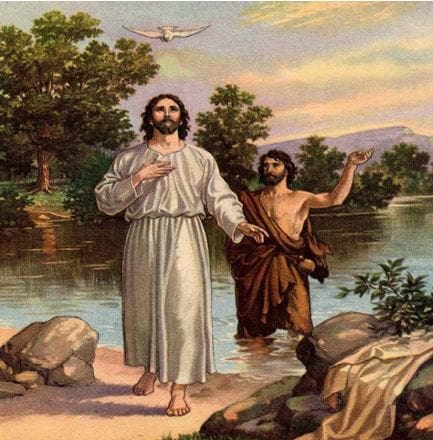Old Testament Reading: 2 Kings 5:10-14 – New Testament Reading: John 1:19-28
Behold the King
“The Coronation of the King”
Matthew 3:13-17
Matthew presents the evidence, event by event, to prove to his Jewish friends that Jesus was the Messiah; the Christ; the King.
- In the first two chapters, Matthew proved Jesus’ deity, His royalty, His parent’s integrity, and John the Baptists’ prophetic authenticity.
- All this was in preparation for that final historic event that would reveal Jesus as the Savior He was sent to be and inaugurate His three-year public ministry.
- That event was His baptism by John in the Jordan River.
1. The Willingness of the Son – Matthew 3:13-15
– Verse 13 – “Then cometh Jesus from Galilee to Jordan to be baptized of him.” (John)
- “Then” – Luke 3:21 – “When other people were being baptized…then Jesus was also baptized.”
- “Cometh” – God chose this time to reveal Jesus as the God-sent Savior and to launch His public ministry.
- “From Galilee” – Mark 1:9 – “From Nazareth of Galilee” to Bethabara – a distance of around 60 miles.
- “To be baptized of him” – John’s baptism was for repentance of sin. If Jesus was the Messiah, why would He want or need to be baptized by John?
- “It becometh us to fulfill all righteousness” – John had to baptize Jesus because it was according to God’s will: Jesus came to “identify” with the sinners He came to save. Isaiah 53:12, 2 Corinthians 5:21
“He who had no sin at all took His stand with those who had no righteousness at all. He who was without sin went down in the waters of baptism designed for sinners, to prove He was a friend to sinners.”
- By going down into the water, Jesus symbolized His death and burial. By being lifted out of the water, He symbolized His resurrection and His victory over sin, death, and the grave, for all who would believe in Him.
- Jesus did not come just to “tell” us how to be saved or just to “show” us how to be saved – He came to save us from the eternal penalty of our sin.
- Jesus, who did not need to be baptized, walked 60 miles to be baptized by John, not only to reveal the price of our salvation, but to reveal Himself as a friend of sinners, and His willingness to pay the price to redeem us from sin.
- Hallelujah, what a Savior!
2. The Witness of the Spirit – Matthew 3:15-16 –
– Verse 16 – “When [Jesus] was baptized and went up out of the water: lo, the heavens opened unto him, and he saw the Spirit of God descending like a dove, and lighting upon him.”
Jesus told us to baptize those who believe the gospel and receive Him as their Savior, as an act of righteousness, and to do it in the name of the Father, the Son, and the Holy Spirit.
- The Greek word for baptism is “baptizo” and means to submerge, immerse, or to dip.
- This was the accepted meaning of the word until 311 when the Council of Ravenna accepted sprinkling, and in 1645, when some of the Protestant groups agreed.
- The message of repentance John was preaching required a full conversion, a total transformation, a heart purified from sin, to prepare for the entrance of the King.
- To illustrate this would require more than sprinkling or pouring. It would require full immersion.
- To give us an accurate picture of His death, burial, and resurrection, Jesus had to go into the water and to come out of the water.
When Jesus came up out of the water, the Holy Spirit descended upon Jesus “like a dove” lights upon a perch.
- A dove is the essence of the Holy Spirit – gentle, meek, innocent, humble: illustrating Jesus’ earthly ministry.
- A dove was also a sacrifice for the common people.
- Luke 4:18 – Jesus said the Spirit of the Lord was upon Him to “preach to the poor, heal the brokenhearted, deliver the captives, open the eyes of the blind, and bring freedom to those who were being held captive by sin.”
- For three years, Jesus’ primary ministry was to the poor and needy – those who knew they needed a Savior and were ready to believe in Him.
- In His deity, Jesus did not need to be anointed by the Holy Spirit, for He was already one with God the Father and God the Holy Spirit.
- In His humanity, Jesus would need the strength of the Holy Spirit to carry out His mission, to live His life as an illustration of what God was like, and to give His life as a propitiation for those He came to save.
- At His inauguration, Jesus was empowered by the Holy Spirit to prove Himself to be our God-sent Savior.
- At the moment of our salvation, believers are indwelt and empowered by the Holy Spirit to walk in this wicked world and not be affected by its sin. Galatians 5:16-24
3. The Witness of the Father – Matthew 3:17 – “And lo a voice from heaven, saying, this is my beloved Son, in whom I am well pleased.”
When God required a sacrifice for sin, it had to be perfect, without spot or blemish.
- God’s voice from heaven was to approve His Son as the Supreme Sacrifice for man’s sin.
- God’s voice from heaven was saying He would accept the death of Jesus as the perfect sacrifice for the sins of those who would stop trying to earn their salvation any other way, and believe in Jesus as their Savior and Lord. How?
- By their expressed faith in the gospel, as evidenced by their willingness to be baptized in water, identifying with His death, burial and resurrection, and indicating their willingness to die to themselves so Christ can live His life through them. That is the essence of true Christianity.
- In Romans 12:1-2, the Apostle Paul said, such action is “our reasonable service of worship.”
- Once we see what God has done for us, through Christ, that we could have never done for ourselves, we will see that “dying to self” is the least we can do to show our gratitude for Him and our faith in Him.






